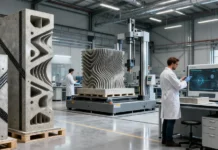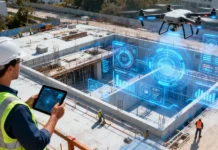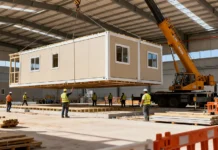Throughout history, material science advances have enabled architectural breakthroughs. Bronze enabled durable weapons and tools. Iron enabled longer spans and greater heights. Steel revolutionized skyscraper development. Concrete democratized infrastructure availability to populations worldwide. Today, another materials revolution unfolds through convergence of nanotechnology, additive manufacturing, biotechnology, and smart material science. Innovative construction materials incorporating nanostructures, self-healing properties, and responsive capabilities are fundamentally transforming how buildings perform, how long they endure, and what environmental impacts they impose.
This transformation goes far beyond incremental performance improvements. Advanced materials enable buildings requiring 50 percent less thermal energy, lasting 30 to 40 percent longer, and generating 60 percent less construction waste than traditional approaches. Smart concrete embedded with carbon nanotubes not only provides structural support but continuously monitors internal stress conditions, enabling predictive maintenance before failures occur. Three-dimensional printed alloys enable construction of complex geometries impossible through traditional fabrication methods while using dramatically less material. These capabilities fundamentally reshape the economics, sustainability, and performance characteristics of built infrastructure.
The construction materials market recognizes this transformation. Organizations worldwide invest heavily in developing and deploying innovative construction materials to capture competitive advantages through superior performance, sustainability, and cost efficiency. Projects utilizing these advanced materials increasingly set new benchmarks for operational performance and lifecycle sustainability.
From Conventional to Intelligent: The Paradigm Shift in Construction Materials
Traditional construction materials—concrete, steel, wood, masonry—possess fixed properties established at the moment of fabrication. A concrete wall displays the same structural properties, thermal characteristics, and durability potential throughout its entire lifetime. Material degradation proceeds predictably according to environmental exposure and structural loading. This static material paradigm constrained designers to predictable performance boundaries, unable to adapt to changing conditions or optimize performance throughout service life.
Advanced materials introduce intelligence and adaptability previously impossible in construction materials. Carbon fiber reinforced concrete senses internal stress distributions. Self-healing concrete repairs minor cracks automatically. Temperature-responsive materials adjust thermal properties based on environmental conditions. Photocatalytic coatings purify air and water through solar activation. These intelligent capabilities transform materials from passive structural elements into active participants in building performance optimization.
The Nanostructure Revolution
The extraordinary performance improvements enabled by advanced materials emerge from deliberately engineered nanostructures—structures so small that individual atomic arrangements influence material properties. When materials incorporate structures at the nanoscale (one billionth of a meter), fundamental material properties change dramatically.
Nano-silica, one of the most extensively studied nanomaterials for construction applications, improves concrete strength through several mechanisms. Nano-silica particles fill microscopic voids within concrete matrix, reducing porosity and creating denser microstructure. This densification improves mechanical properties, reduces permeability, and enhances durability. Research demonstrates that concrete incorporating nano-silica achieves tensile strength increases of approximately 85.3 MPa compared to conventional concrete, while degradation rates decline to approximately 1.2 percent annually compared to higher degradation rates in conventional concrete.
Carbon nanotubes represent another transformative material. These cylindrical structures composed of rolled graphene sheets achieve extraordinary tensile strength—research indicates values reaching 150.8 MPa—along with remarkable toughness and thermal properties. When incorporated into concrete at concentrations between 0.2 and 0.5 percent by volume, carbon nanotubes provide stress-sensing capabilities, enhanced mechanical properties, and superior crack control.
Nano clay offers complementary benefits including enhanced mechanical properties, improved thermal performance, and reduced material degradation. These nanostructured materials, whether utilized individually or in combination, enable concrete and other construction materials to achieve performance levels impossible through conventional fabrication methods.
Environmental Impact Reduction Through Nanomaterials
Beyond performance enhancements, advanced materials incorporating nanomaterials deliver substantial environmental benefits throughout material lifecycles. Nano-silica can partially replace Portland cement—a material responsible for approximately 8 percent of global carbon dioxide emissions—while maintaining or improving structural performance. Thirty percent cement replacement with nano-silica reduces embodied carbon emissions approximately 60 percent per kilogram while simultaneously improving concrete properties.
Carbon nanotubes demonstrate even more dramatic environmental advantages. Embodied carbon emissions decrease 40 percent compared to conventional concrete and 20 percent compared to steel production. Water consumption and cumulative energy requirements similarly decline substantially. Waste production from carbon nanotube reinforced concrete measures approximately 50 percent lower than conventional materials, reducing landfill contributions and resource extraction pressure.
These environmental improvements extend throughout building lifecycles. Buildings constructed from advanced materials achieving superior thermal performance consume less operational energy throughout decades of occupancy. Longer service lives mean less frequent replacement, reducing cumulative resource consumption across multiple decades of building operation. When lifecycle impacts are considered comprehensively from material extraction through end-of-life disposition, innovative construction materials frequently demonstrate total environmental impacts 40 to 60 percent lower than conventional approaches.
Smart Concrete: The Intelligent Building Material
Concrete, the world’s most-used construction material, annually achieves production volumes exceeding water consumption by some measures. Unfortunately, conventional concrete exhibits static properties and limited ability to self-diagnose structural health. Cracks develop imperceptibly. Reinforcement corrosion proceeds invisibly. Structural degradation remains hidden until failures emerge. Smart concrete transforms this paradigm through embedded sensing and self-healing capabilities.
Self-Sensing Concrete for Structural Health Monitoring
Smart concrete incorporating carbon fiber or carbon nanotubes exhibits electrical resistance properties that change when concrete experiences stress or strain. As structural loading changes, electrical properties shift measurably. By continuously monitoring electrical resistance throughout concrete structures, embedded sensors detect stress changes and communicate findings to monitoring systems.
This continuous structural health monitoring enables early identification of problems. When stress concentrations develop, the sensing systems detect them immediately. When cracks begin forming, the stress redistribution becomes apparent to monitoring systems. This early warning enables maintenance interventions before problems escalate into critical failures. Building managers can schedule preventive maintenance during convenient intervals rather than responding to emergency failures disrupting operations.
The sensing capability proves particularly valuable for structures experiencing exceptional loading conditions—buildings in seismic zones, bridges experiencing vibration from traffic, infrastructure exposed to environmental extremes. By detecting stress changes as they develop, structural health monitoring systems enable proactive intervention maintaining structural integrity.
Self-Healing Concrete for Extended Service Life
Cracking represents a primary failure mechanism in concrete structures. Cracks enable water penetration, exposing reinforcement to corrosion and concrete to environmental degradation. Traditional approaches apply surface sealants attempting to prevent moisture from entering cracks. Self-healing concrete introduces internal repair capabilities that automatically seal cracks as they develop.
One approach embeds microbes within concrete that activate when moisture penetrates developing cracks. These microbes generate calcium carbonate that fills cracks, sealing them from further moisture penetration. The biological process occurs naturally, requiring no external intervention. As long as moisture triggers the process, cracks seal automatically.
Another approach incorporates polymer capsules within concrete that rupture when crack formation creates mechanical stress. Released polymers flow into crack spaces, harden, and seal them. This capsule-based approach provides immediate sealing response without requiring biological activation.
A third methodology utilizes shape memory alloys that deploy when cracks develop, mechanically closing crack openings. These diverse self-healing concrete approaches share the common benefit of extending concrete service life by decades through crack self-sealing that prevents water penetration and reinforcement corrosion.
Research demonstrates that self-healing concrete extends service life from conventional 50-year design life to potentially 100+ years through this automatic repair capability. For infrastructure representing enormous capital investments, these extended service lives translate into dramatic cost reductions when amortized across total lifecycle periods.
Three-Dimensional Printing and Additive Manufacturing
Traditional concrete formwork creates geometric limitations constraining design possibilities. Reinforcing steel must accommodate rectilinear shapes. Complex forms require expensive custom formwork. Material efficiency suffers when designs must conform to formwork constraints. Three-dimensional printed concrete (3DCP) and additive manufacturing technologies eliminate formwork constraints entirely, enabling geometric optimization impossible through conventional methods.
Design Freedom and Material Optimization
3D concrete printing technologies build structures additively by depositing successive concrete layers according to computer-programmed patterns. This deposition process enables creation of complex geometries—curved walls, topologically optimized structures, integrated load paths—that traditional formwork cannot accommodate economically.
When freed from formwork constraints, structural designers can implement topology optimization algorithms that identify load paths supporting structural function while minimizing material volume. Structures designed through these algorithms often achieve 30 to 50 percent weight reductions compared to conventionally designed alternatives while maintaining equivalent or superior structural performance.
A prefabricated modular floor structure utilizing 3D-printed concrete and post-tensioning achieved approximately 60 percent concrete volume reduction compared to conventional reinforced slabs. Embedded periodic minimal surface structures increased surface area for carbonation while maintaining structural efficiency. This design innovation demonstrates how innovative construction materials combined with advanced manufacturing enable structures that simultaneously optimize for multiple performance objectives—load-carrying capacity, sustainability, embodied carbon reduction, and carbon sequestration.
Carbon-Absorbing Concrete for Climate Mitigation
Concrete production generates approximately 8 percent of global anthropogenic carbon dioxide emissions. Reducing concrete carbon impact represents a significant opportunity for climate mitigation. Traditional approaches focus on cement replacement with supplementary materials. Advanced materials researchers have developed carbon-absorbing concrete formulations that actively sequester atmospheric carbon dioxide.
One approach replaces 30 percent Portland cement with naturally abundant silica biominerals possessing hierarchical pore structures. This substitution reduces embodied carbon approximately 60 percent per kilogram of concrete. Additionally, the porous structure of these biominerals enables enhanced carbon sequestration. When the carbon-absorbing concrete absorbs atmospheric carbon dioxide through a process called carbonation, the sequestration efficiency reaches approximately 489 grams of carbon dioxide per kilogram of cement—142 percent higher than conventional concrete.
Three-dimensional printed structures incorporating carbon-absorbing concrete and optimized geometric structures that maximize surface area for carbonation demonstrate carbon sequestration rates 175 percent higher than conventional concrete. For large structures, this enhanced carbon-sequestration capability enables net-negative embodied carbon—buildings storing more carbon than they generate during manufacture. Construction literally becomes a climate mitigation strategy rather than an environmental burden.
Construction Efficiency Through Additive Manufacturing
Beyond material performance improvements, 3D printing dramatically accelerates construction. Traditional concrete placement requires formwork installation, concrete pouring, curing, and formwork removal. Three-dimensional concrete printing eliminates most of this process. The printer deposits concrete where needed. No formwork requires installation or removal. No labor-intensive concrete placement occurs. No extended curing period delays subsequent construction phases.
Research indicates that 3D concrete printing can reduce construction duration by approximately 95 percent for specific applications compared to traditional methods. Labor requirements decline 50 to 80 percent. Carbon emissions from construction workers decrease substantially. These dramatic efficiency improvements make 3D concrete printing particularly attractive for applications requiring rapid deployment or labor-constrained regions with insufficient construction workforce.
Advanced Structural Materials and High-Performance Solutions
Beyond concrete innovations, advanced materials science advances continue developing novel structural materials with superior performance across multiple dimensions.
Fiber-Reinforced Polymers and Composite Materials
Fiber-reinforced polymers (FRPs) incorporate high-strength fibers—carbon, glass, or aramid—within polymer matrices creating materials with strength-to-weight ratios exceeding traditional steel and concrete. These composite materials enable lighter structures requiring smaller foundation systems while maintaining equivalent load-carrying capacity.
Applications include bridge rehabilitation where FRP reinforcement restores capacity to deteriorated reinforced concrete structures without massive excavation and reconstruction. Building retrofits utilize FRP reinforcement to upgrade earthquake resistance. Marine structures benefit from FRP’s superior corrosion resistance compared to steel in salt-water environments.
Self-Compacting Concrete and Ultra-High-Performance Concrete
Self-compacting concrete flows under its own weight without vibration or mechanical consolidation, enabling rapid placement and superior surface finishes. Ultra-high-performance concrete (UHPC) achieves compressive strengths exceeding conventional concrete by multiples, enabling thinner, more elegant structures with reduced material volume.
UHPC applications include pedestrian bridge structures capable of elegant spans previously requiring conventional steel or large conventional concrete members. Building facades utilize UHPC’s superior surface finish capabilities and durability to create aesthetic expressions impossible with conventional materials. Infrastructure applications benefit from UHPC’s superior durability in aggressive environments.
Recycled and Bio-Based Materials
Innovative construction materials research increasingly focuses on recycled and bio-based alternatives to virgin materials. Recycled plastic composite lumber provides an alternative to traditional wood lumber for applications tolerating structural material properties between traditional lumber and conventional structural composites.
Bio-based concrete incorporating agricultural waste products such as rice husks or coconut fiber as supplementary cementitious materials or reinforcement provides sustainable alternatives while supporting agricultural waste utilization. Mycelium-based composites growing fungal networks through agricultural waste create lightweight, biodegradable materials suitable for interior finish applications and temporary construction structures.
Nanocomposites and Multi-Functional Materials
The convergence of nanotechnology with materials science enables creation of nanocomposites—materials incorporating nanostructures that provide multiple functional capabilities beyond traditional structural support.
Photocatalytic Concrete for Air and Water Purification
Concrete incorporating titanium dioxide nanoparticles becomes photocatalytic, meaning it catalyzes chemical reactions when exposed to ultraviolet light. These photocatalytic surfaces decompose air pollutants and water contaminants, potentially purifying surrounding air and water.
In urban environments experiencing air quality challenges, photocatalytic concrete pavements and building surfaces can contribute to air quality improvement while buildings function. Water contaminated with organic pollutants can be purified by passage through photocatalytic concrete filters. These multi-functional materials provide structural support while simultaneously providing environmental benefits—a integration of function demonstrating the potential of innovative construction materials.
Thermal Energy Storage Materials
Phase-change materials incorporated within construction materials absorb thermal energy during periods of temperature increase and release stored energy during cooling periods. This thermal buffering capability reduces building heating and cooling loads, improving thermal comfort while reducing operational energy.
Passive solar buildings incorporating phase-change materials in structural elements or surface materials achieve superior thermal performance without mechanical systems. Conventional buildings maintaining constant temperature despite fluctuating environmental conditions require substantial mechanical heating and cooling. Buildings incorporating thermal storage materials respond more gradually to temperature fluctuations, reducing mechanical system requirements and operational energy.
Electromagnetic Shielding Materials
Electronic equipment generates electromagnetic fields that can interfere with sensitive instruments or cause biological effects of uncertain magnitude. Construction materials incorporating conductive particles or fibers provide electromagnetic shielding, protecting enclosed spaces from external fields or preventing internal fields from escaping.
Healthcare facilities, data centers, and research laboratories benefit from these shielding capabilities. Buildings incorporating electromagnetic shielding materials create protected environments for sensitive activities while enabling normal operation of electronic systems without interference concerns.
Implementation Challenges and Solutions
Despite extraordinary performance benefits, advanced materials face adoption barriers requiring strategic attention.
Cost Considerations and Economic Analysis
Innovative construction materials frequently command premium pricing compared to conventional alternatives, partly because they represent newer technologies with smaller production volumes and limited supplier competition. First-cost premiums often reach 20 to 40 percent compared to conventional materials.
However, comprehensive lifecycle cost analysis frequently reveals that total cost of ownership remains competitive or favorable despite higher first costs. Extended service lives mean less frequent replacement. Reduced operational energy requirements reduce long-term costs. Reduced maintenance requirements decrease lifecycle expenses. When these factors are considered comprehensively, many advanced materials demonstrate favorable total cost of ownership despite higher initial pricing.
Technical Knowledge and Installation Expertise
Innovative construction materials often require installation procedures and technical knowledge differing from conventional approaches. Contractors accustomed to traditional materials may lack experience with advanced alternatives. This knowledge gap can lead to improper installation, performance disappointments, and delayed market adoption.
Industry education, demonstration projects, and technical support from material manufacturers help overcome these barriers. As market volumes increase and industry expertise develops, installation expertise becomes more widespread and premium costs associated with specialized knowledge decline.
Performance Validation and Building Code Approval
Building codes conservative in approach require extensive testing and historical performance data before accepting novel materials. Manufacturers must conduct comprehensive testing programs, develop performance documentation, and work with code development organizations to establish acceptance criteria. This validation process requires substantial investment and time before novel materials receive formal code recognition.
Future Outlook and Emerging Opportunities
Innovative construction materials research continues advancing rapidly with several emerging directions promising additional performance improvements and applications.
Biotechnology integration with construction materials—utilizing engineered organisms to enhance material properties or enable new functions—represents an emerging frontier. Research explores utilizing bacterial incorporation within concrete to enhance durability and enable self-healing capabilities. Mycelium-based composites grown from fungal networks offer sustainable, biodegradable alternatives with carbon-negative embodied energy.
Artificial intelligence optimization of material formulations enables discovery of material combinations achieving optimized performance across multiple objectives. Machine learning algorithms explore vast formulation spaces identifying solutions humans might never discover, enabling creation of materials with unprecedented performance characteristics.
Integration of innovative construction materials with renewable energy generation—solar-responsive coatings generating electrical energy, piezoelectric materials converting structural vibration to electricity—transforms buildings into contributors to energy systems rather than purely consumers of energy.
Conclusion: The Built Environment’s Materials Future
The materials revolution in construction represents far more than incremental performance improvements. The convergence of nanotechnology, additive manufacturing, biotechnology, and smart material science fundamentally reshapes what materials can accomplish. Advanced materials enable structures lighter, stronger, more durable, and more sustainable than traditional approaches. Smart concrete provides structural support while monitoring its own health and repairing damage automatically. Three-dimensional printed alloys enable geometric optimization impossible through conventional methods.
For construction professionals, developers, and organizations committed to building excellence and environmental responsibility, innovative construction materials represent essential tools for next-generation infrastructure. The evidence from successful deployments worldwide—from energy-efficient buildings to self-healing infrastructure to carbon-sequestering structures—demonstrates that these materials deliver promised benefits reliably across diverse applications.
As material science continues advancing and production volumes increase, innovative construction materials transition from specialty applications to mainstream adoption. The built environment of the coming decades will incorporate these advanced capabilities routinely rather than considering them extraordinary innovations. Organizations positioning themselves to understand, specify, and deploy these materials effectively will capture substantial competitive advantages in an evolving marketplace increasingly demanding superior performance and environmental responsibility.































